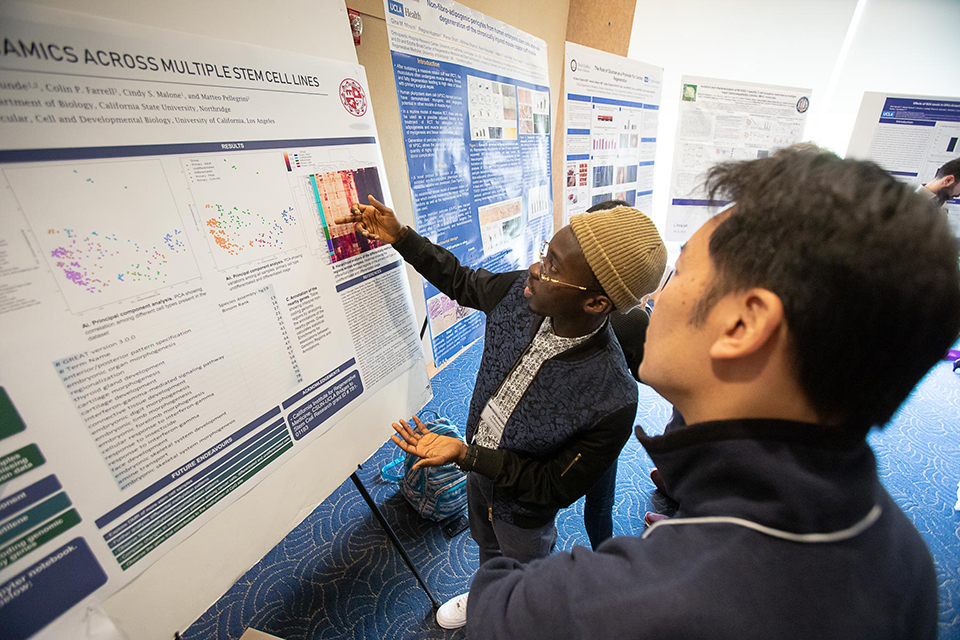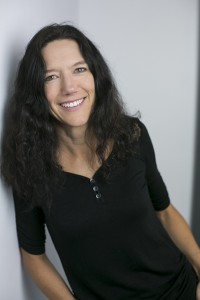CSUN Receives $3.6M for Undergraduate Stem Cell Research Training

Ahmed Oyetunde (left), a former CSUN-UCLA intern in the lab of UCLA’s Matteo Pellegrini, presents his research project at the UCLA Broad Stem Cell Research Center’s 15th annual Stem Cell Symposium. Credit: Reed Hutchinson, UCLA Broad Stem Cell Research Center
California State University, Northridge has received a $3.6 million grant from the California Institute for Regenerative Medicine, known as CIRM, to prepare undergraduate students for careers in stem cell research.
The five-year grant will continue and build on the highly successful CSUN-UCLA Stem Cell Scientist Training Program, which CSUN has run in collaboration with the Eli and Edythe Broad Center of Regenerative Medicine and Stem Cell Research at UCLA since 2010. The program prepares CSUN undergraduates for careers in stem cell research through intensive coursework and internships in leading UCLA research labs.

Cindy Malone
“The CSUN students who participate in the program are fully engaged in CIRM’s and the UCLA Broad Stem Cell Research Center’s shared mission of accelerating the delivery of stem cell and gene therapy treatments to patients in need,” said Northridge biology professor Cindy Malone, director of the CSUN-UCLA Stem Cell Scientist Training Program. “Outside of their time working in UCLA labs, they volunteer in patient advocate programs to meet and learn from real patients whose lives their research aims to improve. These critical interactions shape our trainees’ understanding of why the work they are doing is so important.”
The CSUN-UCLA training program is part of CIRM’s Bridges to Stem Cell Research and Therapy initiative, which aims to train the next generation of stem cell scientists and make California’s regenerative medicine workforce more representative of the state’s population. The new grant to CSUN will provide 10 undergraduates from diverse backgrounds each year with training that will serve as a springboard into careers in the fields of stem cell biology and regenerative medicine.
The top CSUN students selected for the competitive program complete coursework and training in advanced stem cell research techniques, policy and ethics, as well as in patient advocacy, community outreach, science communications and critical race theory. Trainees also gain hands-on experience through year-long, full-time paid internships conducting research in the labs of UCLA faculty, who are world leaders in cell and molecular biology, bioengineering and molecular medicine, among other disciplines.
As part of the new grant, each trainee may intern in one of 50 labs affiliated with the UCLA Broad Stem Cell Research Center, as well as the UCLA Jonsson Comprehensive Cancer Center. While interning at UCLA, trainees are given the opportunity to immerse themselves in the university’s dynamic and highly collaborative research environment through lab meetings, seminars, journal clubs and poster presentations at symposia.
The grant to CSUN’s program at UCLA was one of 15 awards — totaling $51 million — that CIRM approved in July to support Bridges programs for undergraduate and graduate students enrolled at universities and colleges throughout California.
Between 2009 and 2019, CIRM supported 16 Bridges programs that trained more than 1,400 scientists. The agency reports that about half of these program graduates are now working full time in research positions at biotechnology companies or academic research institutions, and another third are currently enrolled in graduate or professional schools.
“As the field advances, we must … meet the demand for promising young scientists,” Dr. Maria T. Millan, president and CEO of CIRM, said in a press release. “The CIRM Bridges programs across the state of California will provide students with the tools and resources to begin their careers in regenerative medicine.”

 experience
experience